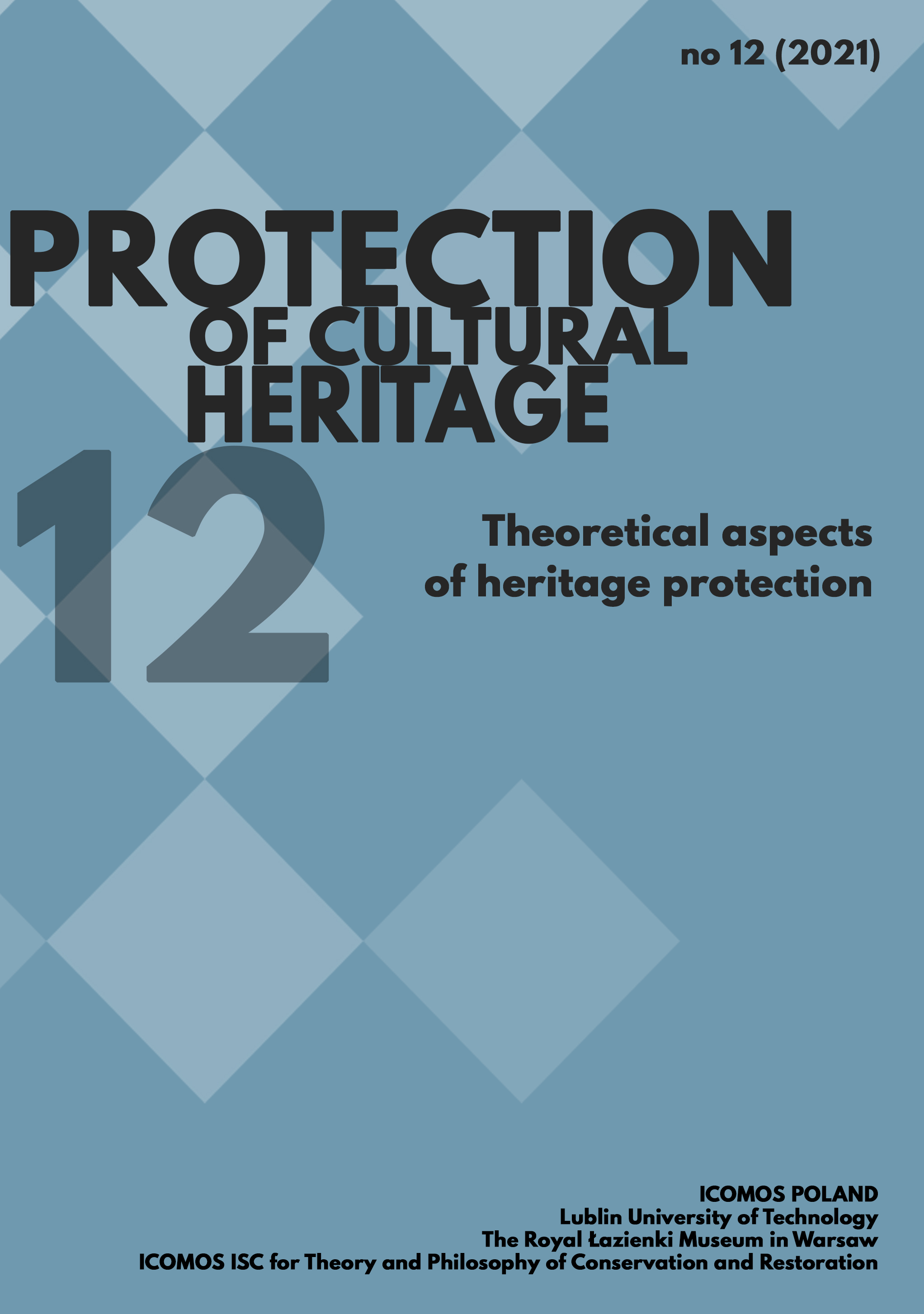Archeological Monuments Protection System. Between Theory and Conservation Practice
Article Sidebar
Open full text
Issue No. 12 (2021)
-
Pierre Nora’s "Sites of Memory" and the Social Aspect of Issues in Built Heritage Conservation
Janusz Krawczyk, Małgorzata Balcer1-12
-
Learning from the Abode of Chaos : Institutions, Stakeholders and Contemporary Challenges of Conservation Doctrine
Claudine Houbart13-24
-
Archeological Monuments Protection System. Between Theory and Conservation Practice
Agnieszka Krawczewska25-34
-
Conservation Doctrines and the Pan-European Idea of the New European Bauhaus and the European Green Deal
Marcin Włodarczyk, Małgorzata Włodarczyk35-54
-
Alert in the 21st Century. Changes in Theory of Heritage Protection in Tangible, Intangible and Digital Signs
Iwona Szmelter55-70
-
Urban Conservation in International Charters
From the Athens Charter to the Historic Urban Landscape RecommendationRuxandra-Iulia Stoica71-78 -
The Climate Change Related Adaptation and Resilience of Traditional Tradicional Dwellings: the Case of Yucatan Penisula
Joel Audefroy, Bertha Nelly Cabrera Sanchez79-96
-
Conservation Practice and the Future of Doctrinal Texts
Nigel Walter97-112
-
The Congress of Athens of 1931: Methodological and Technical Contributions for the Conservation of Architectural and Environmental Heritage
Rosa Anna Genovese113-121
-
Reflections on Integral and Integrated Heritage Care at the Threshold of the Third Millennium
Marc Laenen123-138
-
World Heritage for Building Peace
Paolo Del Bianco141-147
Main Article Content
DOI
Authors
agnieszka.krawczewska@powiat.poznan.pl
Abstract
The beginnings of archaeological conservatorship in Poland were primarily the process of identification of historical sites and their inventory, which is a fundamental determinant of effective protection of remnants of ancient human material culture.
The recent emergence of non-invasive research methods in the field of science and their use in Polish archaeology has meant that the hitherto inventory of archaeological sources associated with tedious standard field surveys can be carried out quickly and spectacularly. While the need for modern research techniques is indisputable and necessary in every scientific discipline, it is no less important not to stop at the stage of data acquisition, which contributes to the creation of a database of archaeological sites to be protected, but does not provide the expected answer to the question: how to protect them?
The following questions arise during the conservation of inventories of archaeological sites: where and what are the temporal and material limits of the protection of archaeological heritage? The variety of registered examples of relics of terrain forms from the traces of former ploughing, through the negatives of historical architectural objects to the lines of war trenches or lists of modern objects acquired in the course of searching for monuments require the conservator to make the right decisions, which not infrequently arouse extreme reactions. So is the protection of archaeological monuments being carried out efficiently?
Archaeological conservation should be viewed as a complex process consisting of three elements: "inventory, protection, management", where management is understood in terms of long-term conservation programs developed for specific groups of archaeological monuments. The Act of 23 July 2003 on Monuments Protection and Care in force in our country enables the application of a number of effective measures, however, the current system of monuments protection is still focused on "inventory" and "protection", and the third element "management" is still extremely difficult to implement.
Keywords:
References
Konopka, M. (2011). Raport w sprawie archeologii – podziemnych zabytków dziedzictwa kulturowego. W: System ochrony zabytków w Polsce –analiza, diagnoza, propozycje. red. B. Szmygin (75-88): Lublin-Warszawa: Polski Komitet Narodowy ICOMOS, Biuro Stołecznego Konserwatora Zabytków Urzędu Miasta Stołecznego Warszawa, Politechnika Lubelska.
Purchla, J. (red.).(2008). Raport na temat funkcjonowania systemu ochrony dziedzictwa kulturowego w Polsce po roku 1989. Dostęp 19 grudzień 2021 r. z https://www.nck.pl/badania/raporty/system-ochrony-dziedzictwa-kulturowego-w-polsce-
Zakrzewski, Z. (1921). Sprawozdanie z działalności państw. Urzędu konserwatorskiego na b. dzielnicę pruską. Wiadomości Archeologiczne, VI, 167-169.
Dekret Rady Regencyjnej o opiece nad zabytkami sztuki i kultury (Dz.U.1918 nr 16 poz. 36).
Ustawa z dnia 23 lipca 2003 r. o ochronie zabytków i opiece nad zabytkami (t.j. Dz.U.2021.710 ze zm.).
Article Details
Abstract views: 345
License

This work is licensed under a Creative Commons Attribution-ShareAlike 4.0 International License.






